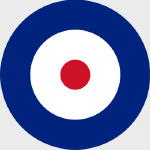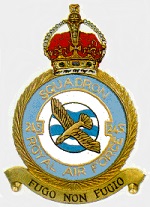Corgi AA36513 RAF Hawker Typhoon Mk. Ib Ground Attack Aircraft - MP147, Flt. Lt. Harrison Taylor "Moose" Mossip, No.245 (Northern Rhodesian) Squadron, RAF Homesley South Airfield, Hampshire, England, August 1944 (1:72 Scale)
"Fugo Non Fugio" ("I put to fight, I do not flee")
- Motto of No.245 Squadron
 The Typhoon was a British single-seat strike fighter, produced by Hawker Aviation starting in 1941. Intended as a replacement for the Hawker Hurricane in the interceptor role, it suffered from performance problems, but eventually evolved into one of World War II's most successful ground attack aircraft.
The Typhoon was a British single-seat strike fighter, produced by Hawker Aviation starting in 1941. Intended as a replacement for the Hawker Hurricane in the interceptor role, it suffered from performance problems, but eventually evolved into one of World War II's most successful ground attack aircraft.
Even before the new Hurricane was rolling off the production lines in March 1937, Sidney Camm had moved on to designing its future replacement as a private project. This was to be a massive plane designed around the equally massive Napier Sabre engine. The work proved useful when Hawker received specification F.18/37 in January 1938 from the Air Ministry, which asked for a fighter based around either the Napier Sabre or the Rolls-Royce Vulture engine. The engines were similar in that they were both 24 cylinder designs that were designed to deliver over 2,000 hp (1.5 MW), and different primarily in the arrangement of the cylinders - an H-block in the Sabre and an X-block in the Vulture.
The two resulting models became known as the 'R' and 'N' (based on the engine manufacturer) and were very similar - the Vulture powered R plane had a rounder nose profile and a ventral radiator, whereas the Sabre powered N had a flatter deck and a chin mounted radiator. The basic design of both continued the Hawker tradition of using 'older' construction techniques; the front fuselage was welded steel just like the Hurricane, and the design used a massive 40 foot (12 m) wing that was much thicker than those on designs like the Spitfire. Camm did give in to the times for much of the rest of the plane though; it was semi-monocoque from the cockpit rearward, flush riveted, and had wide set gear. Instead of sliding or lifting canopy the Typhoon came with a side door.
The R version first flew in October 1939, and the RAF was so impressed they ordered 1,000 as the Tornado. Various problems, notably compression effects which were previously unknown to Hawker, slowed the acceptance down. In addition the plane had rather disappointing climb performance, which meant it wouldn't be the Spitfire-replacing interceptor they were looking for. In February 1940 the first N model, now known as the Typhoon, was delivered. The RAF placed a large order for it as well, but moved production to Gloster Aircraft who had no designs to produce at the time. Like the Tornado, the Typhoon was soon demonstrating its own problems, including vibrations from the engine causing the wing's skin to peel.
Eventually the RAF cancelled all work on both models in May 1940 so that Hawker could concentrate solely on the Hurricane during the Battle of Britain. This was the design's first brush with death. Some small-scale work continued, changes to streamline the fuselage and supply a much thinner wing were looked at, as well as alternate engines in the form of large radials. In October pressure on the RAF eased and work was allowed to continue on the two original designs.
The first full production version Tornado was delivered in early 1941 and demonstrated the then unheard of speed of 425 mph fully armed. This was also the last Tornado. While production lines were being drawn up, the Vulture engine project was suddenly terminated by Rolls-Royce and the Tornado was left without an engine. However the Typhoon had 'good enough' performance to warrant production. The first production Mk.IA was delivered in May 1941 with twelve Browning .303 guns, but this was followed quickly with the Mk.IB with four Hispano 20 mm cannons.
By this time the Spitfire Vs were meeting Focke-Wulf Fw 190s in combat and getting rather beaten up, so the Typhoon was rushed into squadron service (with 56 & 609 Sqn) to counter the new German plane. Sadly this proved to be a disaster. An apparent structural weakness in the tail meant that it tended to break off when pulling out of dives, the Fw's favourite escape. Once again there was talk of killing the design. The cause of these tail-failures (in which only one of the pilots survived to give any clue to the reason) was found to be fatigue failure of the elevator mass-balance, allowing elevator-flutter to occur which was at its greatest when pulling-out of a dive. As a "temporary" measure, rectangular strengthening "fishplates" were riveted around the fuselage/empennage joint - the site of the failures. These fishplates remained a feature on all subsequent Typhoons. Problems with leakage of exhaust fumes into the cockpit and subsequent high carbon monoxide levels meant Typhoon pilots had to use oxygen for even low level operations. Due to the efforts of operational pilots like S/L Roland Beamont (of 609 Sqn) the Typhoon continued under development despite these design drawbacks.
This particular 1:72 scale aircraft was flown by Flt. Lt. Harrison Taylor "Moose" Mossip, who was attached to No.245 (Northern Rhodesian) Squadron, then deployed to Homesley South Airfield, Hampshire, England, during June 1944.
Sold Out!
Dimensions:
Wingspan: 7-inches
Length: 5-1/4-inches
Release Date: December 2021
 Historical Account: "Shark Mouth" - Despite the fact that the deep chin radiator of the Hawker Typhoon fighter was particularly suited to the application of some aggressive looking nose artwork, most RAF aircraft, particularly Hawker Typhoons, rarely featured anything more than their standard squadron colors during WWII. One high profile exception to this rule was Typhoon IB MP147, an aircraft which featured a fearsome array of teeth behind its bright blue spinner, making it one of the most distinctive RAF aircraft in the European Theatre. Thought to be the only Typhoon to feature a representation of sharks teeth on its radiator, MP417 'Sharky' was issued to RAF No.245 Squadron in August 1944, whilst Allied units were engaged in the savage fighting around the Falaise Pocket and remained with the squadron until it disbanded on August 15th the following year.
Historical Account: "Shark Mouth" - Despite the fact that the deep chin radiator of the Hawker Typhoon fighter was particularly suited to the application of some aggressive looking nose artwork, most RAF aircraft, particularly Hawker Typhoons, rarely featured anything more than their standard squadron colors during WWII. One high profile exception to this rule was Typhoon IB MP147, an aircraft which featured a fearsome array of teeth behind its bright blue spinner, making it one of the most distinctive RAF aircraft in the European Theatre. Thought to be the only Typhoon to feature a representation of sharks teeth on its radiator, MP417 'Sharky' was issued to RAF No.245 Squadron in August 1944, whilst Allied units were engaged in the savage fighting around the Falaise Pocket and remained with the squadron until it disbanded on August 15th the following year.
Logbook entries show that Sharky was flown by successful Canadian pilot Flt. Lt. Harrison Taylor "Moose" Mossip, who had been awarded the Distinguished Flying Cross for his previous successes operating the Typhoon with RAF No.1 Squadron. Known to possess a particularly aggressive flying style, Mossip was one of the pilots who helped to establish the reputation of the Typhoon in the ground attack role and it is thought that these sharkmouth markings were applied to this aircraft in recognition of this tenacious flying style. Significantly, this aircraft flew operationally during WWII whilst wearing these markings.


